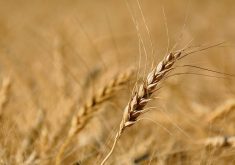Chicago | Reuters — U.S. corn futures climbed to a one-week high on Tuesday after the U.S. Department of Agriculture (USDA) made a bigger-than-expected cut to its yield estimate due to unprecedented planting delays this spring.
USDA, in a monthly report, slashed its corn yield projection by 10 bushels an acre from May, or 5.7 per cent, to 166 bushels. Analysts had been expected a milder decline to 172.4 bushels.
The drop, along with a three per cent decrease in USDA’s expectation for how many acres farmers will plant, left the government’s production estimate at 13.68 billion bushels. That would be the smallest harvest in four years.
Read Also

Alberta crop conditions improve: report
Varied precipitation and warm temperatures were generally beneficial for crop development across Alberta during the week ended July 8, according to the latest provincial crop report released July 11.
The outlook confirmed fears among traders that heavy rains this spring had put the corn harvest in question. The wet weather delayed farmers from planting corn and raised the risk that the crop could be hurt by hot summer weather or an autumn frost.
“The USDA ripped the Band-Aid off by lowering yield by 10 bushels (per acre) and then also lowering acreage,” said Ted Seifried, chief agriculture market strategist for Zaner Group in Chicago.
The Chicago Board of Trade’s (CBOT) most actively traded corn contract climbed 2.5 per cent, to $4.27-3/4 a bushel.
CBOT wheat gained 2.1 per cent, to $5.18 a bushel, and soybeans rose 0.1 per cent, to $8.59-1/4 a bushel.
Concerns about planting delays last month drove corn futures to a three-year high. Prices have since eased, but farmers remain worried that the planting problems will reduce their profits as the sector is grappling with an ongoing U.S.-China trade dispute that has slowed American agricultural exports.
USDA said late on Monday it is looking into ways to allow farmers who have been unable to plant crops due to rain to qualify for farm aid payments linked to trade disputes.
The agency on Tuesday kept its production and yield estimates for soybeans unchanged from last month, surprising analysts who were generally looking for declines. The crop is typically planted after corn.
Farmers who were unable to plant corn could grow soybeans on those acres instead, adding to soy supplies.
Terry Reilly, senior commodity analyst at Futures International in Chicago, said the eastern Corn Belt needs to dry down significantly for switching to happen.
If weather conditions remain unfavorable during the summer and autumn, USDA could cut to its corn yield estimate further.
“If the weather gives us any reason to think 166 (bushels per acre) isn’t possible, then oh boy things could really get exciting,” Seifried said.
— Reporting for Reuters by Tom Polansek in Chicago; additional reporting by Michael Hogan in Hamburg and Naveen Thukral in Singapore.
















